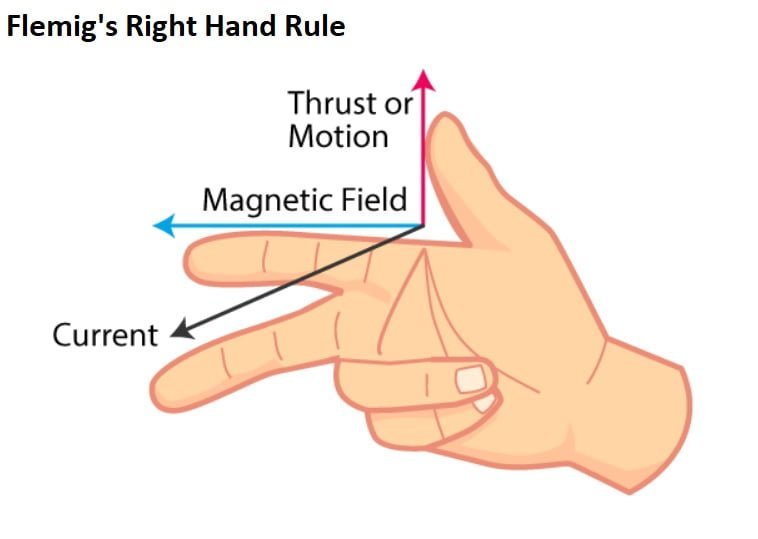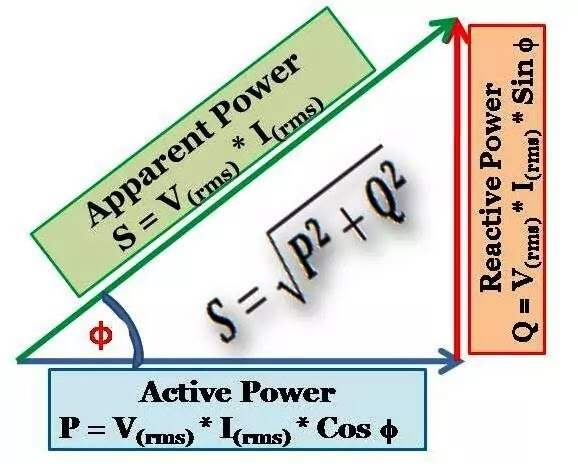Whenever there is a relative motion between the current carrying conductor and the magnetic field, an EMF is induced in the conductor. This is where Fleming’s Right Hand Rule and Fleming’s Left Hand Rule comes into picture.
With Fleming’s Right and Left Hand rule we can find the direction of Magnetic Force, Magnetic Field and direction of current.
As discussed above the relative motion between the current carrying conductor and the magnetic field can be of two types :
- When the current carrying conductor is kept inside the magnetic field, it will experience a force and start rotating. (Working Principle of Motor)
- When a moving conductor is placed inside a magnetic field, an EMF will be induced in the circuit. (Working Principle of Generators)
State Fleming’s Right Hand Rule
According to Faraday’s Law of Electromagnetic Induction, when a moving conductor is placed inside a magnetic field, an EMF is induced in the circuit. And to find the direction of current we use the Fleming’s Right Hand Rule.
Fleming Right Hand Rule helps to find direction of Force, Magnetic Field and Current.
Fleming’s Right Hand Rule states that ” When we point our Thumb, Fore finger and middle finger of our Right Hand in such a way that they are perpendicular to each other and if the thumb represents the direction of movement of conductor and the fore finger represents the direction of magnetic field then the middle finger will give us the direction of the Induced Current“.

Importance
Fleming’s Right Hand Rule is helpful to find direction of Current in Generators.
State Fleming’s Left Hand Rule
When a current carrying conductor is placed in a magnetic field, it experiences a force. The direction of this force acting on the conductor is perpendicular to both the direction of current and direction of the magnetic fields. And this direction of force is found out by using Fleming’s Left Hand Rule.
Fleming Left Hand Rule gives the relationship between the Force experienced by the conductor, Magnetic Field, and the direction of Current.
Fleming Left Hand rule states that ” When we point our Thumb, Fore finger and middle finger of our Left Hand in such a way that they are perpendicular to each other and if the fore finger is representing the direction of magnetic field and the middle finger is representing the direction of current, then the Thumb will give us the direction of force acting on the conductor “.

Importance
Fleming’s Left Hand Rule is helpful in finding the direction of Force experienced by the conductor in Electric Motors.
What is similarity between Fleming left hand rule and Fleming Right hand rule
There is a relation between the magnetic field, the current and the force in both Fleming’s left and right hand rules. This relation is directionally determined by Fleming’s Left Hand rule and Fleming’s Right Hand rule respectively.
These rules do not determine the magnitude but instead show the direction of any of the three parameters (magnetic field, current, force) when the direction of the other two parameters is known.
Frequently Asked Questions
What is difference between Fleming left and right hand rule?
The main difference between Fleming left and right hand rule is that Fleming left hand thumb rule gives the direction of force experienced by the conductor whereas Fleming right hand rule gives the direction of Electric Current induced in the circuit.
What is Fleming’s right hand rule also called?
Fleming’s Right Hand rule is also called as Dynamo Rule. Because this rule is applicable to find the direction of current in Generators or Dynamo.
Who invented Fleming’s right-hand rule?
Fleming right-hand rule was invented by physicist John Ambrose Fleming from Britain in late 19th Century.
Where is Fleming’s left hand rule used?
Electric Motors
Where is Fleming’s Right hand rule used?
Generators / Dynamo
Check Out Other Important Topics
| IC Engine | Important PDFs | Boilers | Synergy Maritime Exam | Naval Arch | MEO Class 4 |
| Interview Questions | Difference Between | Types of Pumps | Auxiliary Machines | Types of Valves | Home |


